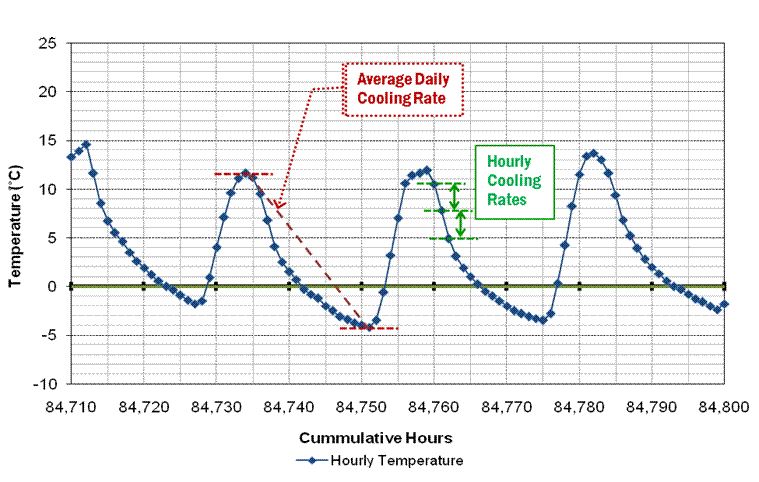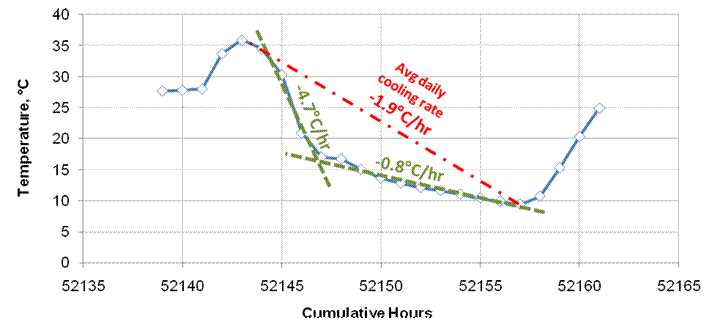|
Asphalt Research Correspondent |
|
A Graphic Look at HMA Pavement Cooling Rates in the Intermountain West
Asphalt Research Consortium researchers, highway agencies, and motorists concur: thermal cracking in the intermountain region of the United States is severe. Now, ARC partners at the University of Nevada, Reno, share their insights from studying pavement temperature histories and cooling rates of hot mix asphalt (HMA) pavements in ten states.
Hourly temperatures of the HMA layer of 14 long-term pavement performance sites covering 10 states within the intermountain region were studied. The Intermountain West is the region between the Rocky Mountains to the east and the Cascades and Sierra Nevada to the west. The sites were located in Arizona, New Mexico, West Texas, Colorado, Utah, Nevada, Wyoming, Idaho, Montana, and South Dakota. Two sections (19 and 25) from the WesTrack project in Nevada were included in the study.
Figure 1 shows the average daily and hourly cooling rates. The average daily cooling rate was calculated from the maximum and minimum temperature of the cooling period of the day. The hourly cooling rate was calculated from the hourly temperatures during the cooling period of the day. Only data corresponding to pavement temperatures of 10oC or colder were analyzed since only these colder periods affect thermal cracking.
Figure 1. Daily and Hourly Pavement Temperature Cooling Rates
The ARC researchers determined that the daily cooling cycle for most of the sections has two distinct cooling rates. As shown in Figure 2, one is steeper than the average daily cooling rate, and the other is flatter. For long-term pavement performance sections with temperature sensors placed at depths of 12-15 mm, the ratio of “high” to “low” rates is 3.7:1.1. The ratio for the WesTrack sections was calculated to be 3.8:1.4.
The same analysis was conducted for sites with temperature sensors at 25 mm, and the ratio was calculated to be 2.8:1.1, which is lower than the ratio for the sensors closer to the surface. This indicates that the cooling curve gets more uniform with depth.
Figure 2. Hourly Pavement Temperature Profile for Section in Kingman, AZ on 5/14/98
|
|
The table below presents cooling rates for sections with temperature sensor depths at 12-15 mm. Note that the dry freeze sections have consistently higher cooling rates than the dry no-freeze sections, indicating a pattern of cooling rates related to climatic classification. At WesTrack, cooling rates for Section 19 were higher than those for Section 25. Section 19 has a fine-plus gradation, whereas Section 25 has a coarse gradation. Gradation appears to play a role in temperature rates in an asphalt pavement, and these rates ultimately play a role in thermal cracking performance. The average daily cooling rates do not capture the higher hourly cooling rates that occur throughout a given day.
Cooling Rates for Sections with Sensor Depths of 12-15 mm
Clearly, HMA pavements in the intermountain region experience two distinct cooling rates within their daily cooling cycle. As the pavement starts cooling from its warmest point, the cooling rate is significantly higher than when it nears its coldest point. In other words, the temperature plunges then glides. The ratio of these two cooling rates is about 3; the ratio of the maximum hourly cooling rate over the average daily cooling rate is about 2.5. Therefore, using the average daily cooling rate to determine the development of thermal stresses within the HMA layer is not a conservative approach.
Consortium researchers at the University of Nevada, Reno propose that the full history of pavement cooling cycles be considered in any analysis of thermal cracking. Next, they will expand the study to compare the cooling rates measured in HMA pavements in the Intermountain West with those of other regions. ARC |

